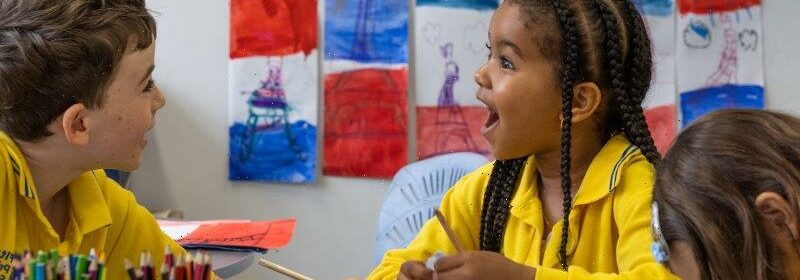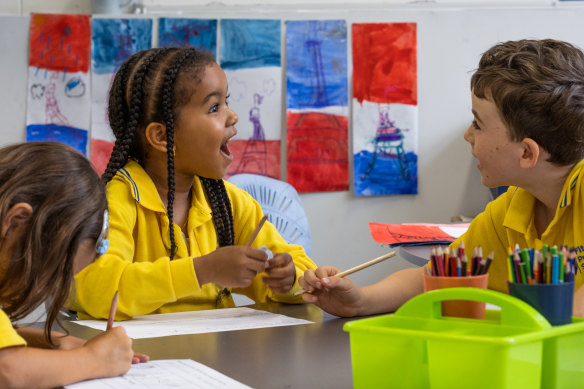How French lessons revived a struggling Melbourne primary school

Fatima is only in grade one, but already speaks three languages: Arabic at home, and English and French at school.
She says she likes French the best.
Fitzroy Primary School students Fatima and Gustav learn in French for 10 hours a week as part of the school’s bilingual program.Credit:Jason South
Fatima goes to Fitzroy Primary School, the latest state school in Victoria to adopt a bilingual program and the only one in Melbourne’s north that offers bilingual French.
The school’s embrace of bilingual learning has helped to spark a revival in its fortunes.
Four years ago, when the school first dipped its toe in bilingual education and introduced four hours a week in French for one class of 20 children, it had just over 100 students.
They were drawn mostly from families of North African refugee backgrounds living in Fitzroy’s public housing towers. Local middle-class families were bypassing the school, which had become an island of disadvantage in one of Melbourne’s most gentrified suburbs.
The school has progressively stepped up its bilingual program to 10 hours a week of literacy and numeracy classes in French and 11 hours of instruction in English.
The French teacher workforce has grown from one to six, and with them has come an influx of French-speaking families: 25 at the latest count, including 13 children in prep this year.
For the first time in many years, local professional families in Fitzroy have also begun to enrol their children in significant numbers, changing the school’s profile to one that is less disadvantaged.
Principal Angela Richmond said the school now better reflects the full diversity of Fitzroy.
“What I’ve always wanted for Fitzroy Primary is for the family situation to really mirror the families that live within its zone, and what I was concerned about in our growth is that we would no longer be attracting families that live in local [public] housing,” Richmond said.
Richmond was worried that adopting French would alienate some students.
“Fortunately, that hasn’t happened,” she said.
When Richmond became principal in 2019, moving from Richmond West Primary, she was struck by how little locals knew about what was happening at the school – not even staff at nearby early learning centres knew.
It was “a bit of a mystery school”, she said.
Richmond decided that the school needed to create a stronger identity and build its brand with locals.
She toured the kindergartens and briefed the educators about the school’s new French bilingual program. She even spread the word in local cafes.
Her approach worked. Enrolments have doubled since 2019 to 210 and are projected to reach 300 in coming years.
The school’s heritage building is being modernised at a cost of $9.27 million to welcome the future students.
Jill Blackmore, professor of education at Deakin University, said research had shown that students from disadvantaged backgrounds benefit academically when they learn in diverse classrooms that include students from more privileged backgrounds.
She said children also benefit socially from being in a school that is strongly connected with its community.
“Kids know they are at a school that other kids walk past, so to feel that they are now valued in their community, a part of that community, they have ongoing benefits,” she said.
“A sense of belonging is very important for kids.”
The Morning Edition newsletter is our guide to the day’s most important and interesting stories, analysis and insights. Sign up here.
Most Viewed in National
From our partners
Source: Read Full Article
